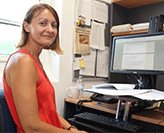Second-hand smoke
A study of cigarette smoke exposure in multi-unit housing by HMRI Public Health researcher Associate Professor Billie Bonevski has been instrumental in achieving proposed NSW Strata by-law reforms banning smoking in common areas.

In a paper just published in the international journal Preventive Medicine, Associate Professor Bonevski, from the University of Newcastle, drew extensive data from almost 161,000 participants in the NSW-wide 45 and Up study.
Among this group, more than 12,000 people, including 8,000 non-smokers, were routinely exposed to smoke in their homes for eight hours or more per week – more than 7,000 were exposed for at least eight hours per day.
Multi-unit dwellers were 19 per cent more likely to be exposed than those living in houses, with women more likely to be exposed than men because they tend to spend more time at home.
Associate Professor Bonevski said the study resulted from an approach by the former ASH Australia health group seeking reliable data on second-hand smoke exposure.
"I was surprised by the number of people reporting exposure to second-hand smoke in their homes and workplaces because we tend to think of Australia as a mostly non-smoking society with a lot of existing restrictions on smoking in public places," she said.
"It wasn't surprising however that we found exposure was highest among those living in postcode areas classified as lower socio-economic status. In Australia the general population smoking rate is 15-18 per cent whereas among low income earners, the unemployed and those with mental illness, for example, rates are 50 per cent and as high as 90 per cent.
"A lot of Government-subsidised buildings are occupied by those from socially disadvantaged groups so the non-smoking residents are really at high risk of being exposed to toxic, carcinogenic nicotine drift."
Associate Professor Bonevski said that previous international research had tracked how nicotine travels through buildings via elevator shafts, stairwells, air-conditioning systems and even under balcony doors.
Living in a smoky environment tended to increase take-up rates and make it harder for people to quit. About 10,000 participants in the study had children residing with them in the unit.
"It's the best feeling, as a researcher, to see the NSW Government respond," Associate Professor Bonevski said. "The data is good, solid, conclusive evidence that second-hand smoking is a problem, and for those results to be taken up by policy makers is the reason we do what we do."
The NSW Government is expected to introduce the by-laws in mid-2014.
* Associate Professor Billie Bonevski from the University of Newcastle is a member of HMRI's Public Health and Brain and Mental Health research programs. HMRI is a partnership between the University of Newcastle, Hunter New England Health and the community.
Contact
- Mark Rothfield, HMRI.
- Phone: 4042 0590 | 0487 617 055
Related news
The University of Newcastle acknowledges the traditional custodians of the lands within our footprint areas: Awabakal, Darkinjung, Biripai, Worimi, Wonnarua, and Eora Nations. We also pay respect to the wisdom of our Elders past and present.